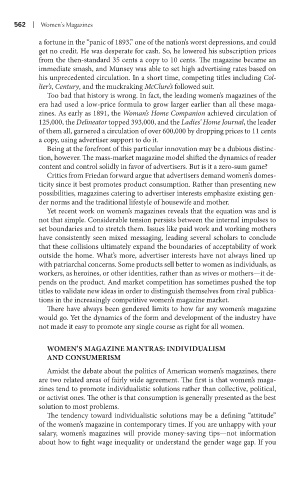Page 583 - Battleground The Media Volume 1 and 2
P. 583
| Women’s Magaz nes
a fortune in the “panic of 1893,” one of the nation’s worst depressions, and could
get no credit. He was desperate for cash. So, he lowered his subscription prices
from the then-standard 35 cents a copy to 10 cents. The magazine became an
immediate smash, and Munsey was able to set high advertising rates based on
his unprecedented circulation. In a short time, competing titles including Col-
lier’s, Century, and the muckraking McClure’s followed suit.
Too bad that history is wrong. In fact, the leading women’s magazines of the
era had used a low-price formula to grow larger earlier than all these maga-
zines. As early as 1891, the Woman’s Home Companion achieved circulation of
125,000, the Delineator topped 393,000, and the Ladies’ Home Journal, the leader
of them all, garnered a circulation of over 600,000 by dropping prices to 11 cents
a copy, using advertiser support to do it.
Being at the forefront of this particular innovation may be a dubious distinc-
tion, however. The mass-market magazine model shifted the dynamics of reader
content and control solidly in favor of advertisers. But is it a zero-sum game?
Critics from Friedan forward argue that advertisers demand women’s domes-
ticity since it best promotes product consumption. Rather than presenting new
possibilities, magazines catering to advertiser interests emphasize existing gen-
der norms and the traditional lifestyle of housewife and mother.
Yet recent work on women’s magazines reveals that the equation was and is
not that simple. Considerable tension persists between the internal impulses to
set boundaries and to stretch them. Issues like paid work and working mothers
have consistently seen mixed messaging, leading several scholars to conclude
that these collisions ultimately expand the boundaries of acceptability of work
outside the home. What’s more, advertiser interests have not always lined up
with patriarchal concerns. Some products sell better to women as individuals, as
workers, as heroines, or other identities, rather than as wives or mothers—it de-
pends on the product. And market competition has sometimes pushed the top
titles to validate new ideas in order to distinguish themselves from rival publica-
tions in the increasingly competitive women’s magazine market.
There have always been gendered limits to how far any women’s magazine
would go. Yet the dynamics of the form and development of the industry have
not made it easy to promote any single course as right for all women.
womEn’s magazinE manTras: inDiviDuaLism
anD ConsumErism
Amidst the debate about the politics of American women’s magazines, there
are two related areas of fairly wide agreement. The first is that women’s maga-
zines tend to promote individualistic solutions rather than collective, political,
or activist ones. The other is that consumption is generally presented as the best
solution to most problems.
The tendency toward individualistic solutions may be a defining “attitude”
of the women’s magazine in contemporary times. If you are unhappy with your
salary, women’s magazines will provide money-saving tips—not information
about how to fight wage inequality or understand the gender wage gap. If you

